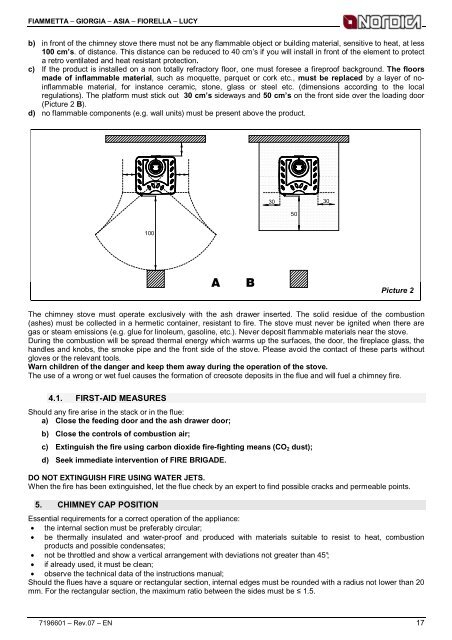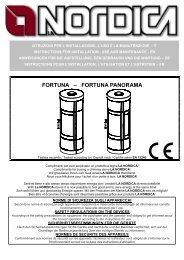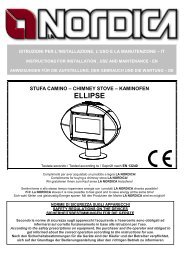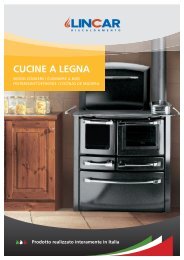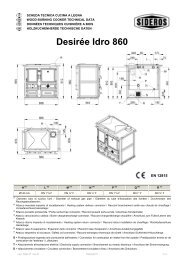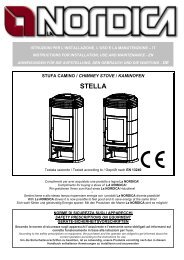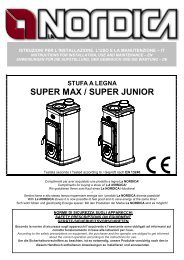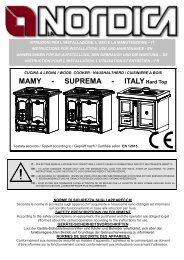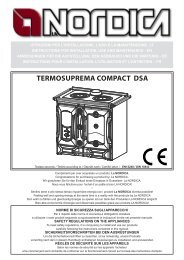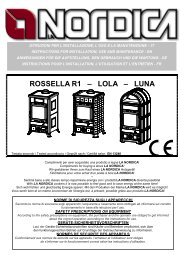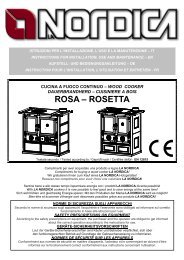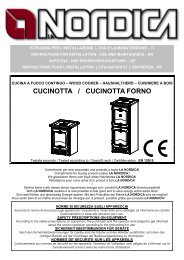FIAMMETTA - ASIA – GIORGIA – FIORELLA - LUCY
FIAMMETTA - ASIA – GIORGIA – FIORELLA - LUCY
FIAMMETTA - ASIA – GIORGIA – FIORELLA - LUCY
You also want an ePaper? Increase the reach of your titles
YUMPU automatically turns print PDFs into web optimized ePapers that Google loves.
<strong>FIAMMETTA</strong> <strong>–</strong> <strong>GIORGIA</strong> <strong>–</strong> <strong>ASIA</strong> <strong>–</strong> <strong>FIORELLA</strong> <strong>–</strong> <strong>LUCY</strong><br />
b) in front of the chimney stove there must not be any flammable object or building material, sensitive to heat, at less<br />
100 cm’s. of distance. This distance can be reduced to 40 cm’s if you will install in front of the element to protect<br />
a retro ventilated and heat resistant protection.<br />
c) If the product is installed on a non totally refractory floor, one must foresee a fireproof background. The floors<br />
made of inflammable material, such as moquette, parquet or cork etc., must be replaced by a layer of noinflammable<br />
material, for instance ceramic, stone, glass or steel etc. (dimensions according to the local<br />
regulations). The platform must stick out 30 cm’s sideways and 50 cm’s on the front side over the loading door<br />
(Picture 2 B).<br />
d) no flammable components (e.g. wall units) must be present above the product.<br />
The chimney stove must operate exclusively with the ash drawer inserted. The solid residue of the combustion<br />
(ashes) must be collected in a hermetic container, resistant to fire. The stove must never be ignited when there are<br />
gas or steam emissions (e.g. glue for linoleum, gasoline, etc.). Never deposit flammable materials near the stove.<br />
During the combustion will be spread thermal energy which warms up the surfaces, the door, the fireplace glass, the<br />
handles and knobs, the smoke pipe and the front side of the stove. Please avoid the contact of these parts without<br />
gloves or the relevant tools.<br />
Warn children of the danger and keep them away during the operation of the stove.<br />
The use of a wrong or wet fuel causes the formation of creosote deposits in the flue and will fuel a chimney fire.<br />
4.1. FIRST-AID MEASURES<br />
Should any fire arise in the stack or in the flue:<br />
a) Close the feeding door and the ash drawer door;<br />
100<br />
b) Close the controls of combustion air;<br />
c) Extinguish the fire using carbon dioxide fire-fighting means (CO2 dust);<br />
d) Seek immediate intervention of FIRE BRIGADE.<br />
DO NOT EXTINGUISH FIRE USING WATER JETS.<br />
When the fire has been extinguished, let the flue check by an expert to find possible cracks and permeable points.<br />
5. CHIMNEY CAP POSITION<br />
A B<br />
Picture 2<br />
Essential requirements for a correct operation of the appliance:<br />
• the internal section must be preferably circular;<br />
• be thermally insulated and water-proof and produced with materials suitable to resist to heat, combustion<br />
products and possible condensates;<br />
• not be throttled and show a vertical arrangement with deviations not greater than 45°;<br />
• if already used, it must be clean;<br />
• observe the technical data of the instructions manual;<br />
Should the flues have a square or rectangular section, internal edges must be rounded with a radius not lower than 20<br />
mm. For the rectangular section, the maximum ratio between the sides must be ≤ 1.5.<br />
7196601 <strong>–</strong> Rev.07 <strong>–</strong> EN 17<br />
30<br />
50<br />
30


